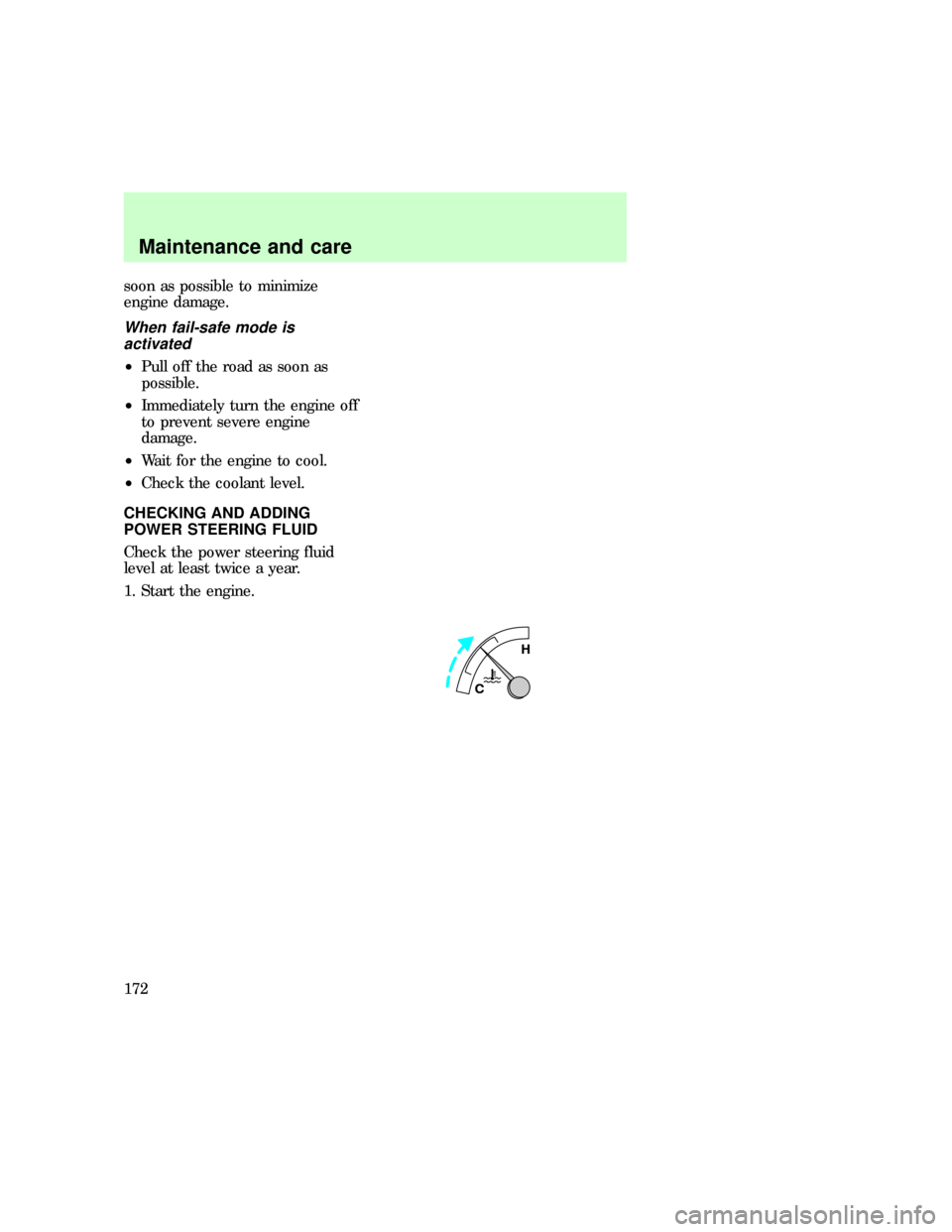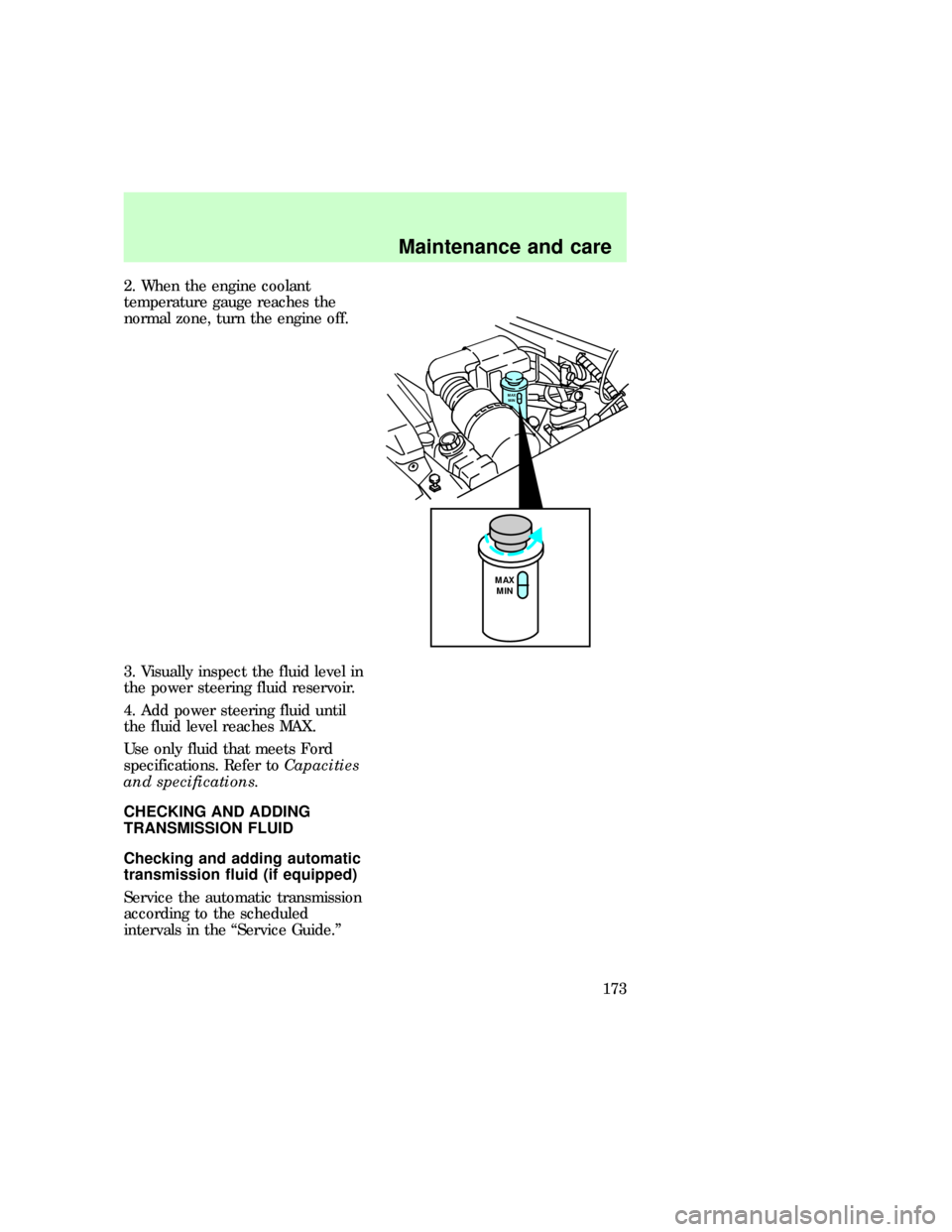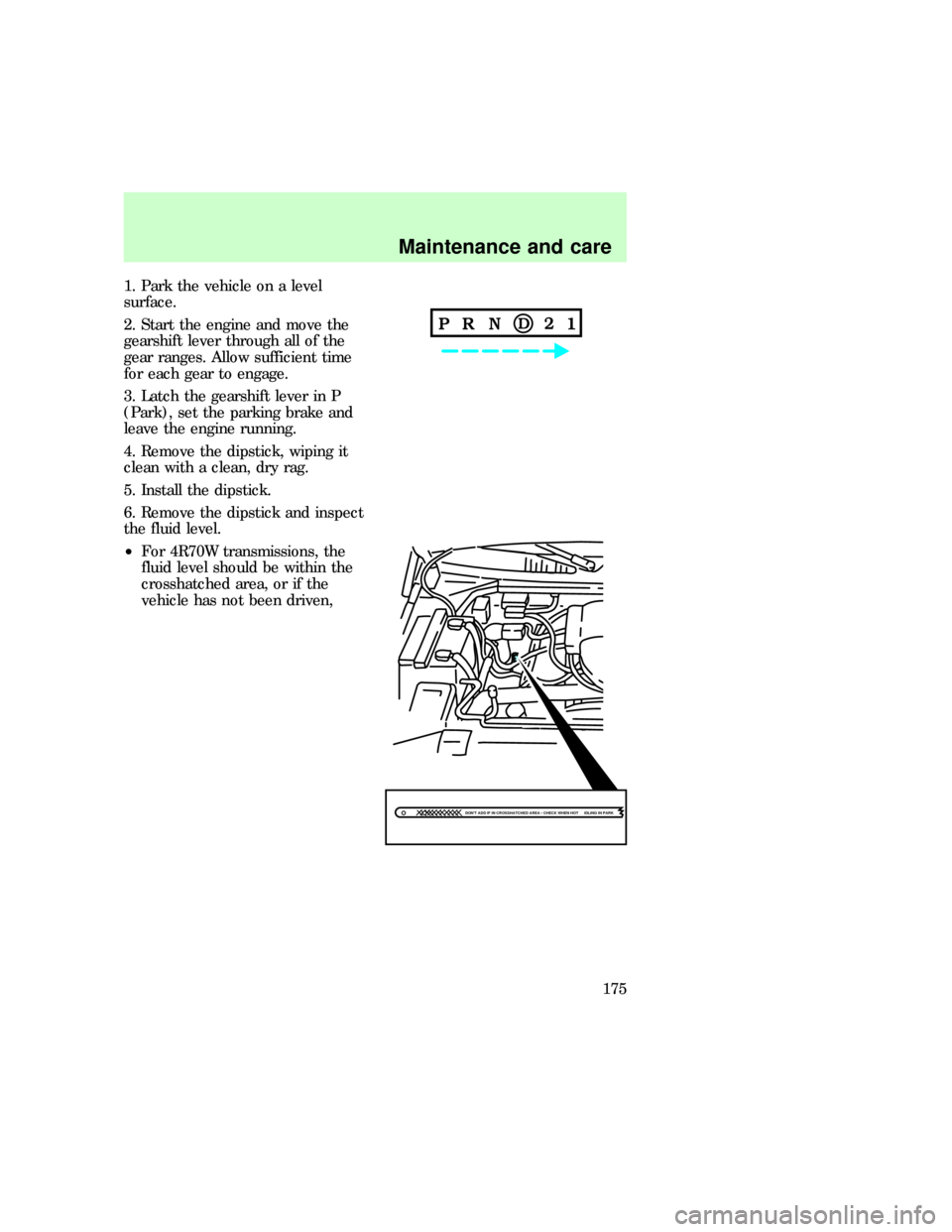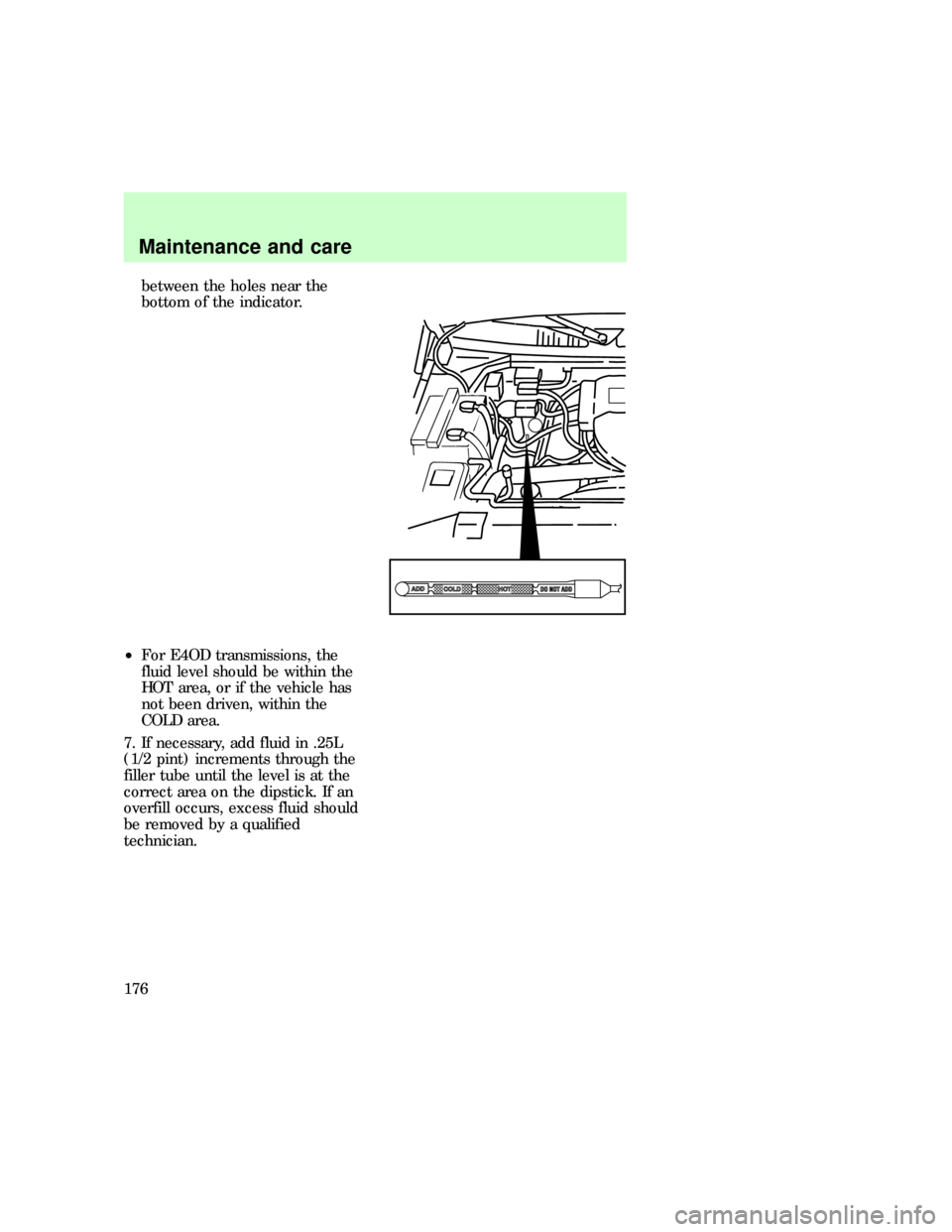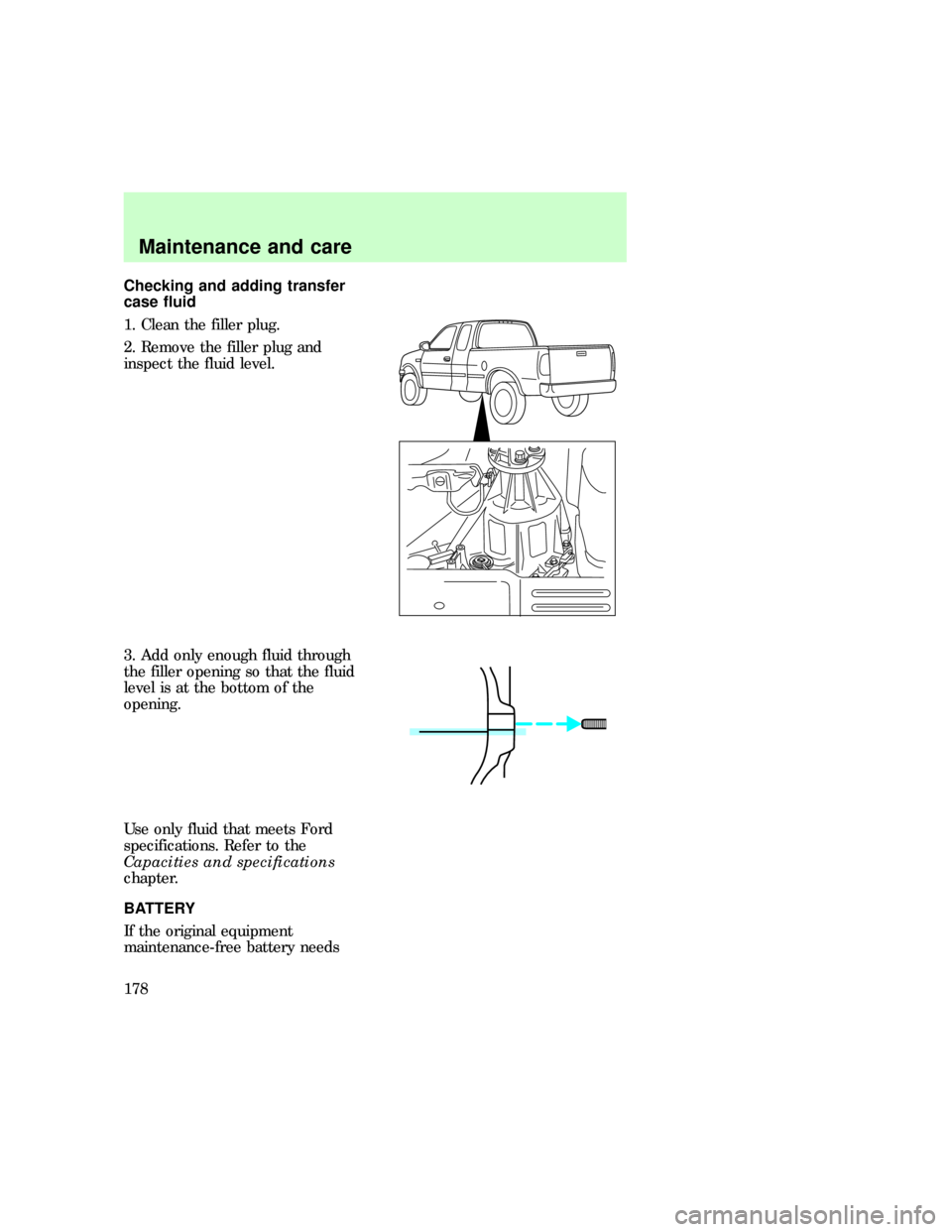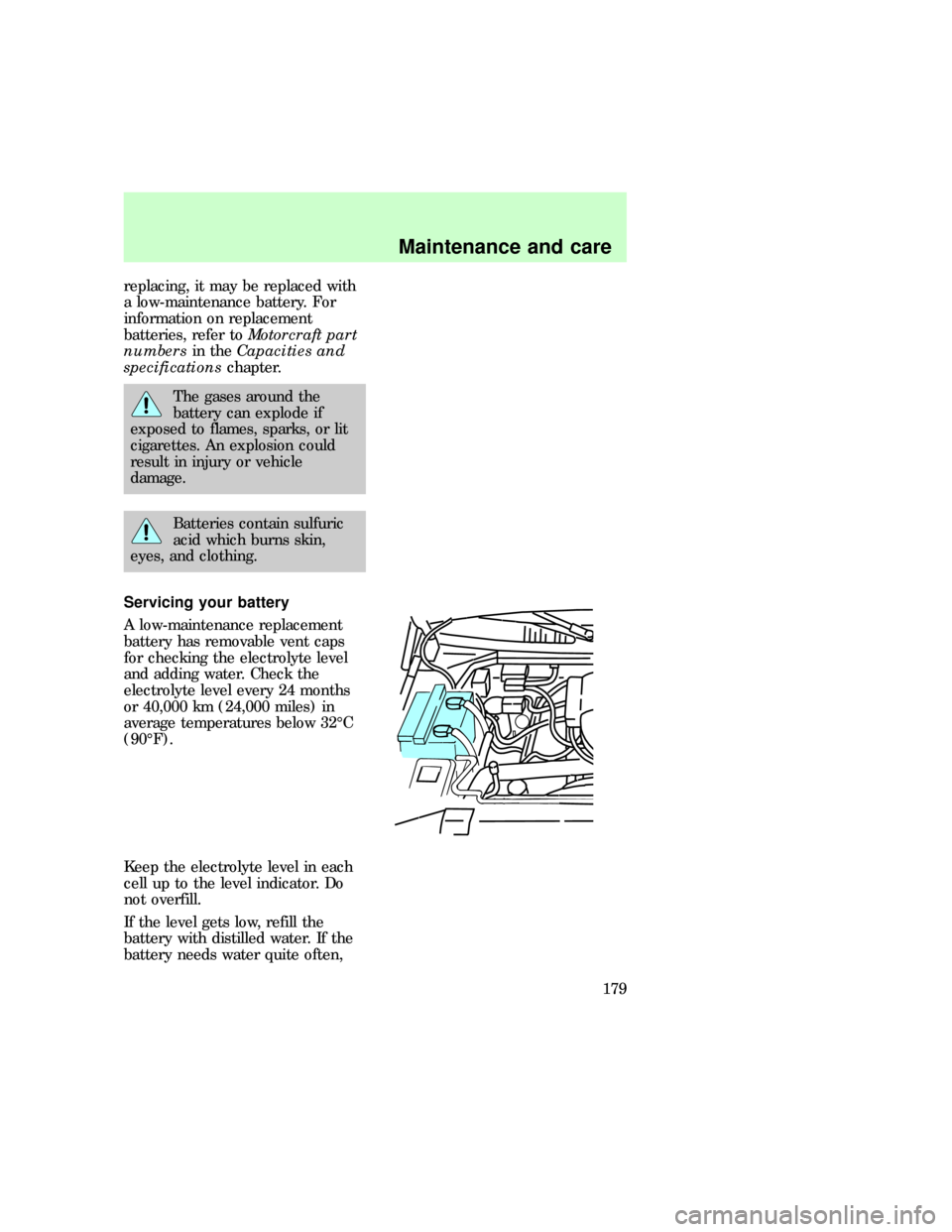FORD F150 1997 10.G Owners Manual
F150 1997 10.G
FORD
FORD
https://www.carmanualsonline.info/img/11/5016/w960_5016-0.png
FORD F150 1997 10.G Owners Manual
Trending: fuel, oil level, low oil pressure, towing capacity, fuel additives, windshield wipers, engine oil
Page 171 of 219
soon as possible to minimize
engine damage.
When fail-safe mode is
activated
²Pull off the road as soon as
possible.
²Immediately turn the engine off
to prevent severe engine
damage.
²Wait for the engine to cool.
²Check the coolant level.
CHECKING AND ADDING
POWER STEERING FLUID
Check the power steering fluid
level at least twice a year.
1. Start the engine.
CHCH
f12_power_steering
Maintenance and care
172
Page 172 of 219
2. When the engine coolant
temperature gauge reaches the
normal zone, turn the engine off.
3. Visually inspect the fluid level in
the power steering fluid reservoir.
4. Add power steering fluid until
the fluid level reaches MAX.
Use only fluid that meets Ford
specifications. Refer toCapacities
and specifications.
CHECKING AND ADDING
TRANSMISSION FLUID
Checking and adding automatic
transmission fluid (if equipped)
Service the automatic transmission
according to the scheduled
intervals in the ªService Guide.º
MAX
MIN
MAX
MIN
f12_trans_fluid
f12_checking_adding_autotrans
Maintenance and care
173
Page 173 of 219

Before adding any fluid, make sure
the correct type will be used. This
information is indicated on the
dipstick.
Do not drive the vehicle if the fluid
level is below the bottom hole on
the blade type dipstick (4R70W
transmission) or below the COLD
area on the bullet type dipstick
(E4OD transmission) and outside
temperatures are above 10ÉC
(50ÉF).
Your vehicle does not use up
transmission fluid. However, it is
recommended that you check the
transmission fluid at least twice a
year. The fluid level should be
checked if the transmission is not
working properly, i.e., if the
transmission slips or shifts slowly
or if you notice some sign of fluid
leakage.
It is preferable to check the
transmission fluid level at normal
operating temperature, after
approximately 32 km (20 miles) of
driving. However, you can check
the fluid level without driving to
obtain a normal operating
temperature if the outside
temperature is above 10ÉC (50ÉF).
If your vehicle has been operated
for an extended period at high
speeds, in city traffic during hot
weather or pulling a trailer, the
vehicle should be turned off for
about 30 minutes to allow the fluid
to cool before checking.
Maintenance and care
174
Page 174 of 219
1. Park the vehicle on a level
surface.
2. Start the engine and move the
gearshift lever through all of the
gear ranges. Allow sufficient time
for each gear to engage.
3. Latch the gearshift lever in P
(Park), set the parking brake and
leave the engine running.
4. Remove the dipstick, wiping it
clean with a clean, dry rag.
5. Install the dipstick.
6. Remove the dipstick and inspect
the fluid level.
²For 4R70W transmissions, the
fluid level should be within the
crosshatched area, or if the
vehicle has not been driven,
DON'T ADD IF IN CROSSHATCHED AREA • CHECK WHEN HOT IDLING IN PARK
Maintenance and care
175
Page 175 of 219
between the holes near the
bottom of the indicator.
²For E4OD transmissions, the
fluid level should be within the
HOT area, or if the vehicle has
not been driven, within the
COLD area.
7. If necessary, add fluid in .25L
(1/2 pint) increments through the
filler tube until the level is at the
correct area on the dipstick. If an
overfill occurs, excess fluid should
be removed by a qualified
technician.
f12_check_add_man_trans_fluid
Maintenance and care
176
Page 176 of 219
Checking and adding manual
transmission fluid (if equipped)
1. Clean the filler plug.
2. Remove the filler plug and
inspect the fluid level.
3. Fluid level should be at bottom
of the opening.
4. Add only enough fluid through
the filler opening so that the fluid
level is 6 mm (3/8 in) from the
bottom of the opening.
Use only fluid that meets Ford
specifications. Refer to the
Capacities and specifications
chapter.
f12_check_add_tcase_fluid
Maintenance and care
177
Page 177 of 219
Checking and adding transfer
case fluid
1. Clean the filler plug.
2. Remove the filler plug and
inspect the fluid level.
3. Add only enough fluid through
the filler opening so that the fluid
level is at the bottom of the
opening.
Use only fluid that meets Ford
specifications. Refer to the
Capacities and specifications
chapter.
BATTERY
If the original equipment
maintenance-free battery needs
f12_battery
Maintenance and care
178
Page 178 of 219
replacing, it may be replaced with
a low-maintenance battery. For
information on replacement
batteries, refer toMotorcraft part
numbersin theCapacities and
specificationschapter.
The gases around the
battery can explode if
exposed to flames, sparks, or lit
cigarettes. An explosion could
result in injury or vehicle
damage.
Batteries contain sulfuric
acid which burns skin,
eyes, and clothing.
Servicing your battery
A low-maintenance replacement
battery has removable vent caps
for checking the electrolyte level
and adding water. Check the
electrolyte level every 24 months
or 40,000 km (24,000 miles) in
average temperatures below 32ÉC
(90ÉF).
Keep the electrolyte level in each
cell up to the level indicator. Do
not overfill.
If the level gets low, refill the
battery with distilled water. If the
battery needs water quite often,
f12_servicing_battery
Maintenance and care
179
Page 179 of 219

have the charging system checked
for a possible malfunction.
Your vehicle is equipped with a
battery saver feature designed to
prevent your battery from
accidental wear down due to doors
left ajar. For information on this
system, refer to theControls and
featureschapter.
Relearning idle conditions
Because your vehicle's engine is
electronically controlled by a
computer, some control conditions
are maintained by power from the
battery. When the battery is
disconnected or a new battery is
installed, the computer must
ªrelearnº its idle conditions before
your vehicle will drive properly. To
complete this process:
1. Put the gearshift in P
(Park)(automatic transmission) or
N (Neutral)(manual transmission).
2. Turn off all accessories, and
start the engine.
3. Let the engine idle for at least
one minute.
4.The relearning process will
automatically complete as you
drive the vehicle.
²If you do not allow the engine to
relearn its idle, the idle quality
of your vehicle may be adversely
affected until the idle is
eventually relearned.
²If the battery has been
disconnected or a new battery
has been installed, the clock and
Maintenance and care
180
Page 180 of 219
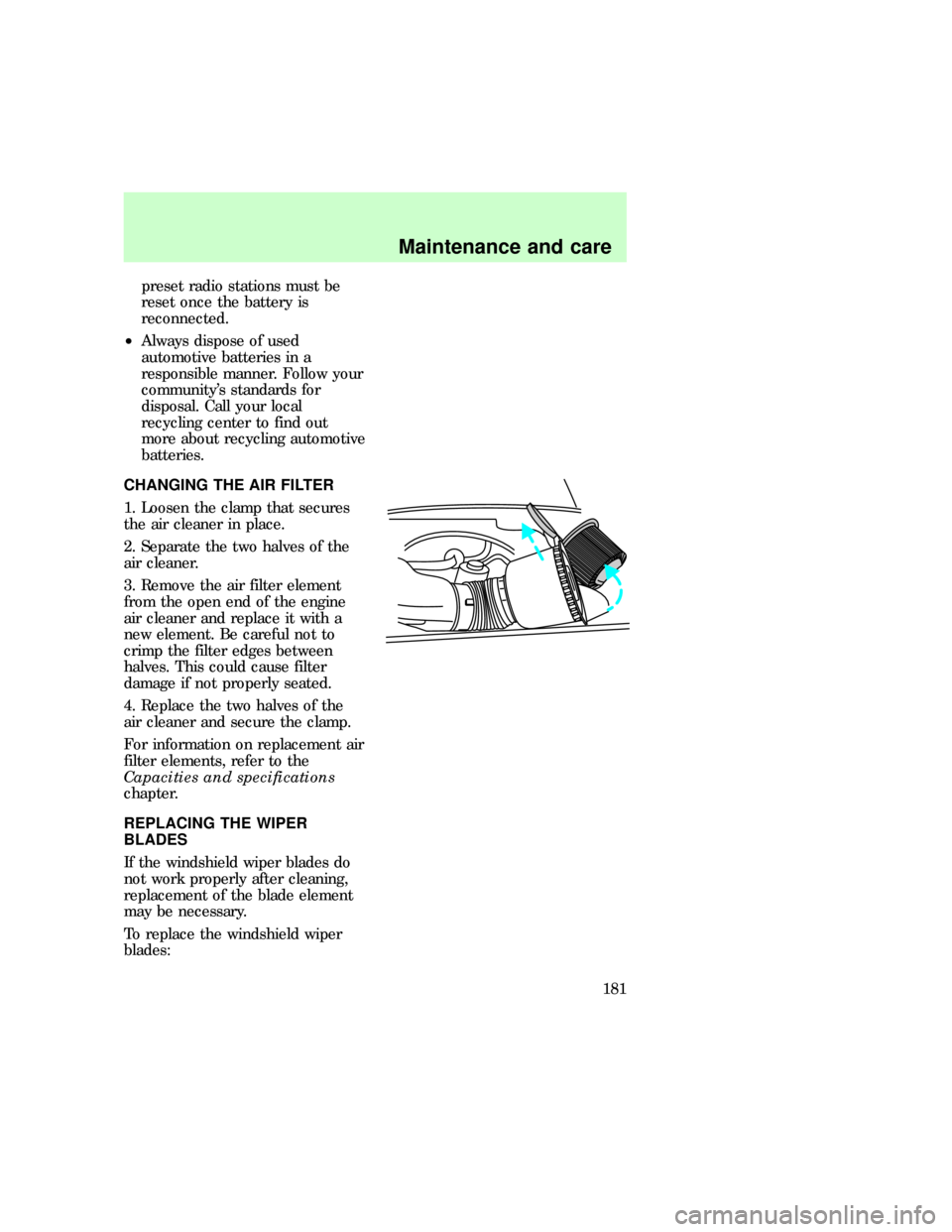
preset radio stations must be
reset once the battery is
reconnected.
²Always dispose of used
automotive batteries in a
responsible manner. Follow your
community's standards for
disposal. Call your local
recycling center to find out
more about recycling automotive
batteries.
CHANGING THE AIR FILTER
1. Loosen the clamp that secures
the air cleaner in place.
2. Separate the two halves of the
air cleaner.
3. Remove the air filter element
from the open end of the engine
air cleaner and replace it with a
new element. Be careful not to
crimp the filter edges between
halves. This could cause filter
damage if not properly seated.
4. Replace the two halves of the
air cleaner and secure the clamp.
For information on replacement air
filter elements, refer to the
Capacities and specifications
chapter.
REPLACING THE WIPER
BLADES
If the windshield wiper blades do
not work properly after cleaning,
replacement of the blade element
may be necessary.
To replace the windshield wiper
blades:
f12_changing_air_filter
f12_changing_wiper_blades
Maintenance and care
181
Trending: windshield wipers, warning light, low oil pressure, wheel torque, brake fluid, seats, spare tire
